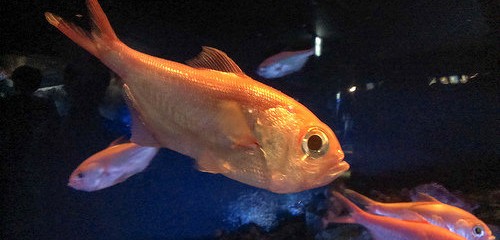5 Tips for Caring for Pet Fish

Goldfish are good starter pets for children due to their short life spans and relatively low-maintenance routine, but don’t mistake low maintenance for no maintenance. True, you won’t have to endure early morning wakeup calls like you would with a puppy or scoop a litter box every day as cat owners do, but fish mommies and daddies still bear some responsibility. If you’re new to owning a pet fish, then you might want to master the basics before diving right in. Lucky for you, we’ve compiled five tips that every new fish owner should know in a single handy list.
- Opt for a large tank. Virtually every cartoon fish in the history of the world has lived in a single small bowl, so your first instinct is probably to go this route. That would be a mistake, though. What you may not know about goldfish is that they tend to eat a lot—and as a result, also happen to excrete a high amount of toxin-filled waste. This means that the water in your tank can quickly become acidic if there isn’t enough of it to dilute the toxins. It’s much easier to keep everything balanced in the tank if you opt for a larger one. A 20-gallon tank is ideal, especially if you anticipate your kids being less than diligent about cleaning.
- Get your fishies acclimated. Now that you’ve picked the proper tank—and presumably filled it with water—it’s time to let your fish stretch their fins in their new home. The ASPCA recommends placing no more than four small or two medium fish in the same tank. When you do, ease them into the new environment. Float the plastic bag that contains each swimmer in the tank for about 15 minutes, allowing the water inside and outside of the bag to reach the same temperature. This should make the transition a little bit easier for your new pets.
- Keep the temperature steady. Speaking of temperature, fish fare best when the temperature of their water remains relatively constant. Since you likely have coldwater fish, you don’t really need to do anything to the tank other than keep it in the same spot, preferably not too sunny or too chilly. Any temperature between 50 degrees and 78 degrees should be perfectly comfortable for your fish.
- Pick the right food (and dole it out sparingly). More likely than not, your fish is an omnivore (though some more exotic fish are strictly herbivores). Your typical flake fish food will have everything such a swimmer needs to remain nourished and healthy. If you have goldfish, they might like a pellet food designed specifically for them.
- Refresh the water. Remember those fish-made toxins we talked about before? Even a 20-gallon tank only does so much to dilute them; you or your kids will need to change the water on a weekly basis in order to ensure your fish stay healthy. You don’t have to completely empty the tank, but take at least a fifth of the water out and replace it with fresh stuff. It’s even better if you replace half of the water.
Fish Care [ASPCA]
5 Tips for Caring for Pet Fish -Parenting-
Feeding Fish -PetSmart-
Image: https://respage-upload.s3.amazonaws.com/img/IMAG1074_BURST001_41.jpg
Attribution: CC-BY-SA-2.0/Flickr nick1au